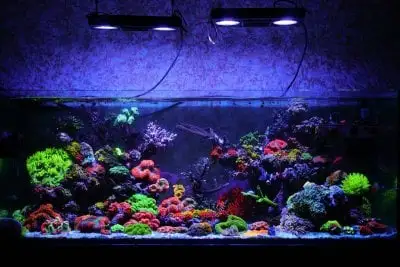Stunning 90-Gallon Reef Tank by Jourdan Sy | Reef2Reef

Tank Specifications
Volume: 90 Gallons / 340 Liters
Dimensions (L × W × H):
48.0" ×
24.0" ×
18.0"
121.9cm ×
61.0cm ×
45.7cm
Equipment List
- Salt: Aquavitro
Frequently Asked Questions
What lighting do you use for your reef tank and why?
I use 2 EcoTech Radion XR30w with TIR lens for my display tank and one Ecotech Radion XR30w Gen 1 for my frag tank. These lights offer a broad color spectrum, which enhances the appearance of the livestock and allows for a unique visual experience throughout the day as the light spectrum changes.
How do I properly maintain my sump system?
My sump has three chambers: one for the overflow, one for the skimmer, and one for the return pump. It's important to clean the skimmer regularly and check for any clogs in the overflow. I also ensure the return pump is functioning properly by periodically checking for any blockages or wear that could affect water flow.
What type of filtration do you recommend for a reef tank?
I currently use a Reef Octopus XP2000 skimmer for protein skimming, alongside a biopellet reactor (JNS Omega Biopellet Reactor) for nutrient control. It's essential to choose a skimmer that matches the tank size and to maintain it for efficient waste removal.
How frequently do you perform water changes, and what salt mix do you use?
I perform water changes approximately every three weeks. I primarily use Salinity by Aquavitro now, but previously I also used Red Sea Coral Pro and Reef Crystals. It's important to use a salt mix that's readily available to you and appropriate for your tank's demands.
What do you feed your fish, and how often?
I alternate between New Era soft pellets, New Life Spectrum pellets, and Otohime pellets. Feeding frequency can vary depending on your fish's needs, but I generally feed my fish daily when I’m around.
How do you care for your corals and ensure their health?
I interchange corals between my display and frag tanks depending on their health and appearance. This allows me to monitor their condition closely. Additionally, I perform regular checks on water parameters to make sure they're within the ideal range for LPS and zoas.
What is the best way to introduce new fish to the tank?
It's important to quarantine new fish before introducing them to the main tank to prevent diseases. After quarantine, I acclimate them slowly to the tank's water conditions by floating the bag in the tank for about 15-20 minutes and gradually mixing tank water into the bag before releasing them.
What types of corals thrive in your tank, and why?
I focus on LPS and zoas as they are generally more resilient and less demanding compared to SPS. The low-maintenance nature of these corals makes them perfect for my setup, especially as I've found they thrive even with limited attention.
What is the trick for maintaining a low-maintenance reef tank?
To maintain a low-maintenance reef tank, I prioritize selecting hardy species like LPS and zoas that can tolerate fluctuations. Additionally, I perform infrequent water changes and delegate feeding when I'm away. Regularly monitoring water parameters also helps in preventing major issues.
How do you handle algae growth in your tank?
I manage algae growth by maintaining good water quality, ensuring proper nutrient balance, and having a clean-up crew that includes snails, shrimp, and other algae eaters. If algae becomes excessive, I'd consider reducing feeding and increasing the frequency of water changes.
What should I do if my corals are not thriving?
First, check the water parameters such as salinity, pH, alkalinity, and nitrate levels to see if they're within the appropriate ranges. If not, make the necessary adjustments. Also, consider the lighting and flow conditions in your tank, as some corals may require specific placement in terms of light and current.